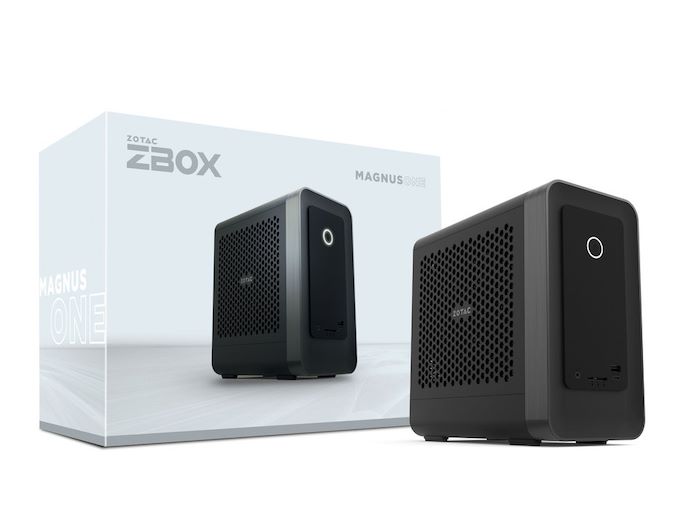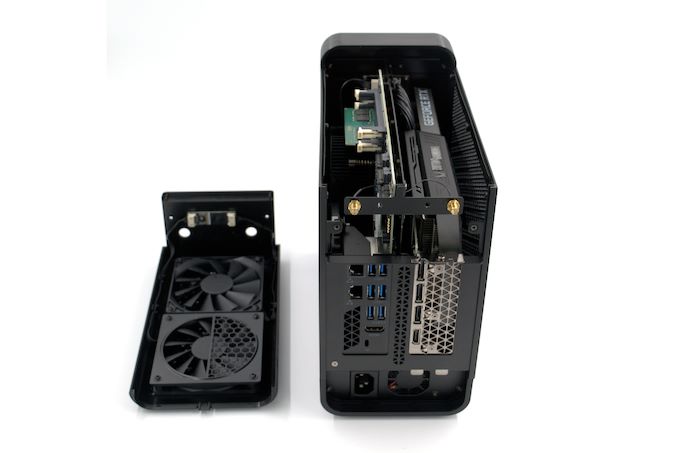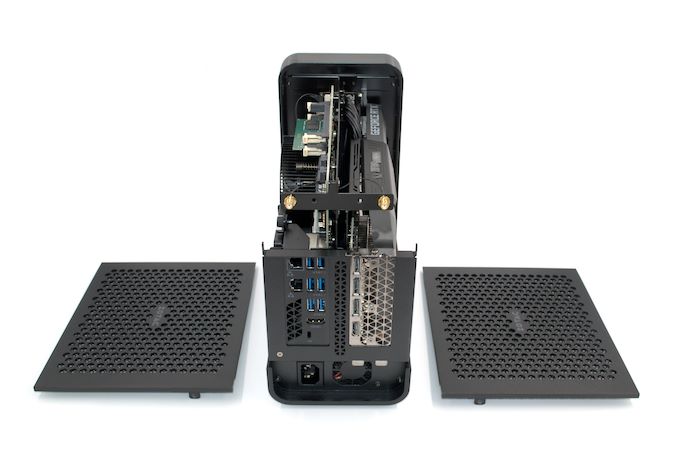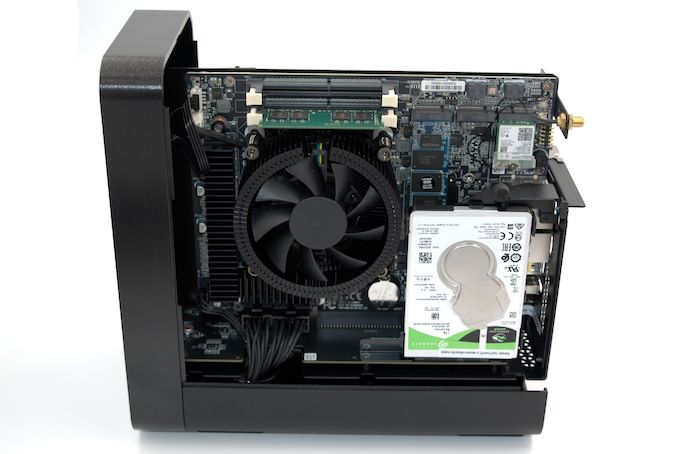Zotac ZBOX MAGNUS ONE SFF Gaming PC Review: Desktop Comet Lake Charges Up with Ampere
by Ganesh T S on August 13, 2021 10:00 AM EST
Zotac has been a pioneer in bringing compact small form-factor (SFF) machines to the market right since the ION days. The introduction of the ZBOX EI750 in 2014 marked the beginning of Zotac's foray into the SFF gaming PC segment. With the burgeoning market for compact systems (kickstarted by the success of the Intel NUC initiative), Zotac has also grown from strength to strength. The company now has around 8 different mini-PC families targeting different segments. The ZBOX E series (E initially stood for 'EPIC GAMING', before becoming the more arcane 'Enthusiast' in recent years) caters to the gaming crowd and is marketed under the MAGNUS tag. The first mini-PC in this series, the ZBOX EI750, used the eDRAM-augmented CrystalWell parts in 2014. The MAGNUS EN970 introduced in 2015 was Zotac's first attempt at integrating a discrete GPU board into the mini-PC form-factor.
Gaming mini-PCs have always had to deal with tradeoffs in terms of processor TDP, GPU TDP, and PSU integration. Almost all of the early gaming mini-PCs involved re-imagining a gaming notebook motherboard in a desktop form-factor - MXM GPUs and sub-45W TDP processors were the norm. Intel's gaming-focused Enthusiast and Extreme NUCs have been upping the ante in this department, and Zotac has also been up to the challenge. The company's current flagship is the ZBOX MAGNUS ONE (introduced at the 2021 CES). Coupling a desktop Comet Lake CPU with a desktop nVIDIA Ampere GPU, it promises plenty of gaming prowess. This review takes a look at the performance and value proposition of the top-end ZBOX MAGNUS ONE model - the ZBOX-ECM73070C-W2B.
Introduction and Product Impressions
Zotac's E-series mini-PCs have enjoyed great success in the gaming mini-PC market, prompting the company to regularly update the lineup with the latest and greatest CPUs and GPUs. Tracing the history of Zotac's flagship E-series systems, we find different tradeoffs applied between the CPU TDP, GPU TDP, and PSU. Higher TDP components have typically carried a premium price tag to accommodate a liquid cooling solution, prompting the company to experiment with air-cooled systems to broaden the market appeal with lower pricing. The details of the gaming flagships in each generation are listed below:
- 2014 ZBOX EI750: CrystalWell (65W TDP for CPU + integrated Iris Pro GPU), 120W external power brick
- 2015 ZBOX MAGNUS EN970: Broadwell-U 15W TDP CPU + 100W TDP GTX 970M, 180W external power brick
- 2016 ZBOX MAGNUS EN980: Skylake-S 65W TDP CPU + 180W TDP GTX 980, 2x180W external power bricks
- 2016 ZBOX MAGNUS EN1080: Skylake-S 65W TDP CPU + 180W TDP GTX 1080, 2x180W external power bricks
- 2017 ZBOX MAGNUS EN1080K: Kaby Lake-S 65W TDP CPU + 180W TDP GTX 1080, 2x180W external power bricks
- 2018 ZBOX MAGNUS EK71080: Kaby Lake-H 45W TDP CPU + 180W TDP GTX 1080, 330W external power brick
- 2019 ZBOX MAGNUS EN72080V: Coffee Lake-H 45W TDP CPU + 150W TDP RTX 2080 Mobile, 330W external power brick
- 2020 ZBOX MAGNUS EN072080S: Comet Lake-H 45W TDP CPU + 150W TDP RTX 2080 Super Mobile, 330W external power brick
- 2021 ZBOX MAGNUS ONE: Comet Lake-S 65W TDP CPU + 220W TDP RTX 3070, 500W internal PSU
Between the MAGNUS EK71080 and the MAGNUS ONE, Zotac started focusing more on the content creators market with their high-end E-series units. The flagship Inspire Studio sported a 65W TDP Coffee Lake-S CPU and a 175W TDP RTX 2060 SUPER, with a form-factor similar to that of the MAGNUS EK71080. The EN72080V and EN072080S were based on the thinner EN970 form-factor. The 2021 MAGNUS ONE thus marks Zotac's strong return to the SFF gaming market with a proper desktop CPU and GPU.
Zotac supplied us with an engineering sample of the high-end MAGNUS ONE SKU - the ZBOX-ECM73070C-W2B. It sports the Intel Core i7-10700 Comet Lake-S CPU and a GeForce RTX 3070 Ampere GPU (Zotac RTX 3070 Twin Edge), along with a 512GB NVMe SSD and a 1TB 2.5" HDD. A 16GB DDR4 SODIMM is also part of the package. Windows 10 Home x64 is pre-installed on the SSD. The whole system is housed in 265.5mm x 126mm x 249mm (10.45in x 4.96in x 9.8in) 8.3L chassis. Taking the cue from Intel's Ghost Canyon NUCs, Zotac has integrated a 500W 80+ Platinum PSU and redesigned the chassis for vertical orientation. These contribute to the creation of a compact and easily transportable system.
Thanks to the integrated PSU, the package contents are largely simplified compared to the other E-series mini-PCs. There is a US AC power cord, two WLAN antennae, a read-only USB key for Windows Image Recovery, and a quick start guide.
The specifications of our review configuration are summarized in the table below:
| Zotac ZBOX MAGNUS ONE (ECM73070C) Specifications | |
| Processor | Intel Core i7-10700 Comet Lake-S, 8C/16T, 2.9 - 4.8 GHz, 14nm+++, 16MB L2, 65W TDP |
| Memory | Crucial CT16G4SFS832A DDR4-3200 SODIMM 22-22-22-52 @ 3200 MHz 1x16 GB |
| Graphics | Zotac Gaming GeForce RTX 3070 Twin Edge 5888 CUDA Cores 8 GB GDDR6 Intel UHD Graphics 630 |
| Disk Drive(s) | Phison E13 Reference Design (Zotac-sourced) (500 GB; M.2 Type 2280 PCIe 3.0 x4 NVMe; Kioxia 96L 3D TLC) (Phison E13 Controller) Seagate BarraCuda ST1000LM048 (1 TB; 2.5in SATA 6Gb/s) |
| Networking | Intel Killer Wi-Fi 6 AX1650x 1 × Realtek RTL8168 Gigabit Ethernet 1 × Killer Ethernet E3000 2.5Gbps controller |
| Audio | 3.5mm Headphone Jack Capable of 5.1/7.1 digital output with HD audio bitstreaming (HDMI / DP) |
| Miscellaneous I/O Ports | 1 x USB 3.1 Gen 1 Type-A (Front) 1 x USB 3.1 Gen 1 Type-C (Front) 1 x SDXC UHS-I (Front) 2 x USB 3.1 Gen 1 Type-A (Rear) 4 x USB 3.1 Gen 2 Type-A (Rear) |
| Operating System | Retail unit is Windows 10 Home x64, but we installed Windows 10 Enterprise x64 |
| Pricing (as configured) | $2400 |
| Full Specifications | Zotac ZBOX MAGNUS ONE ECM73070C with Windows 10 Specifications |
In terms of external appearance, the impact of the Ghost Canyon NUC can be clearly seen. The top panel of the chassis includes a couple of fans. It slides off easily after the two rubber screws are removed. This is a tool-less operation, unlike what we saw in the Ghost Canyon and Beast Canyon NUCs.
The two side panels can be removed once the top panel is out of the picture. This exposes the GPU and the motherboard on either side.
Unlike the NUCs, the M.2 SSD slots, 2.5" drive caddy, and the vertical SODIMM slots are immediately accessible after the side panel's removal.
Since our review sample was essentially a pre-built system, we didn't have to install any new components inside the chassis. Zotac opts to populate only one DRAM channel in the system. This does hamstring the performance of the system, but we opted to review the system as-is in terms of hardware. We did re-image the M.2 SSD with Windows 10 Enterprise x64, as it provides more fine-grained control over benchmarking routines without unexpected interference from the OS.
In the next section, we take a look at the BIOS options along with an analysis of the motherboard platform. Following that, we have a number of sections focusing on various performance aspects before concluding with an analysis of the value proposition of the system.















19 Comments
View All Comments
erinadreno - Friday, August 13, 2021 - link
Seems quite strange that they opt for an H470 chipset but 10th gen CPU. And that cooler is really pathetic even for a 65W CPU. Reminds me of engine 27 which also has really bad performance.abufrejoval - Friday, August 13, 2021 - link
Sadly all 4TB or greater 2.5" HDDs these days use shingled media: I'm not sure I'd want to recommend those, even for a games library.TheinsanegamerN - Friday, August 13, 2021 - link
Why not?abufrejoval - Friday, August 13, 2021 - link
Take ARK Survival Evolved for example, a game that can easily grow beyond 100GB, especially with extra DLC content. Yet it uses tons of smallish files and receives gigabytes of updates every other week. The write amplification for updating these small files will be cached as long as the drive has enough space and been left powered to re-organize and rewrite its shingles.But once it's too full or kept too busy, updates could slow below what your broadband delivers.
Shingled media delivers a 25% capacity increase. I'd rather pay those 25% and have the choice to use CMR. But that choice is no longer there, on 2.5" HDD it's currently SMR or bust (apart from some leftover stockpiles).
Spunjji - Monday, August 16, 2021 - link
As a concept it really does only make good sense for low-rate-of-change media storage and/or where the OS is explicitly aware of the drive's geometry and has appropriate caching systems in place. The decision to sell these drives directly to consumers wasn't the best.abufrejoval - Friday, August 13, 2021 - link
Thunderbolt support with a dGPU is a mess, because you have to re-route the external display ports to TB. TB4 on Gen10 hardware: Don't know if that's done or possible. TB3 would be quite nice already, but if you can't re-route the display, you won't get certified as Thunderbolt, AFAIK, while may would be fine with having support for 4 external PCIe lanes on such a compact PC.abufrejoval - Friday, August 13, 2021 - link
s/may/many--need editjeremyshaw - Friday, August 13, 2021 - link
A decent number of TB3/4 host add-in cards for desktops have DP input, to enable the video pass through. Even TB3/4 integrated on desktop motherboards will usually have a DP input to enable video passthrough (especially AMD MBs, since many of their top consumer CPUs do not have IGPs).RomanPixel - Friday, August 13, 2021 - link
Good choices for hardware I think. Having a 10th over the 11th will lessen heat as well as choosing a RTX 3000 series card with GDDR6 over GDDR6X VRAM. Not a fan of seeing some hybrid or regular HDD thou. I guess if you got the space, go for it! Or maybe it's justified to so many games becoming around 100GB in size now for storage. | If anyone is making small graphics cards it's Zotac with this RTX 3000 series, I don't think it would have been much possible to be any other board partner.Death666Angel - Saturday, August 14, 2021 - link
I have a 2TB SSD system and games drive with a 2TB SSD data drive for musik, videos, pictures and the likes. I can pretty easily install all my most wanted games, so I wouldn't go for an HDD just for games. I have an external HDD for backups and a NAS for backups and my ripped media. How many 100+GB games does one play each week? :) I haven't needed an HDD for programs/games since my 500GB Samsung 840. But I also don't play 5 different AAA games simultaneously, I guess. :DAnd Zotac is great for small form factor graphics cards. I have their 2070 in a small mATX, great card! They aren't even that much more costly I think.